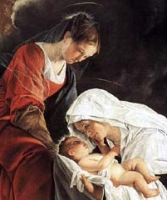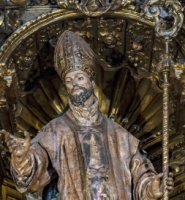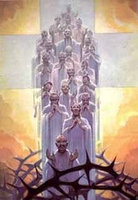| 9 March |
• yesterday • tomorrow |
| Optional Memorial of Saint Frances of Rome, Religious |

• Franziske av Rome
• Francesca Bussa de' Leoni
• Francesca Romana
Born to the aristocracy, the daughter of Paul Bussa and Jacobella de' Roffredeschi. Married at age twelve to Lorenzo de' Ponziani; her marriage lasted 40 years. Mother of three in 1400, 1404, and 1407. Widow.
Benedictine. Foundress of the Oblates of the Tor de' Specchi (Collatines). Said to have been guided by an archangel only she could see. Spent her life and fortune, both as laywoman and religious, in the service of the sick and the poor, including the founding of the first home in Rome for abandoned children. Dictated 97 Visions, in which she saw many of the pains of Hell.
On her feast day priests bless cars due to her patronage of cars and drivers. Frances certainly never drove, but legend says that when she went abroad at night, her guardian angel went before her, lighting the road with a headlight-like lantern, keeping her safe in her travels.
1384 in Rome, Italy as Francesca Bussa de' Leoni
• 1440 in Rome, Italy
• relics at Saint Frances of Rome Church, Rome, Italy
• entombed beneath the pavement of the Ponziani sacristy of the Church of Saint Cecilia, Rome, Italy
29 May 1608 by Pope Paul V
• against plague
• automobile drivers (given in 1951)
• automobilists
• aviators
• cab drivers
• death of children
• lay people
• motorcyclists
• motorists
• people ridiculed for their piety
• pilots
• Roman housewives
• taxi drivers
• widows
• women
• Rome, Italy
• nun with a book
• nun with a monstrance and arrow
• nun with an angel with a branch of oranges nearby
• nun with her guardian angel dressed as a deacon
• receiving the veil from the Christ Child in the arms of the Blessed Virgin
• woman habited in black with a white veil, accompanied by her guardian angel, and sometimes carrying a basket of food
• books
• medals and pendants
• bracelets
• rosaries
• other items
Saint Frances of Rome and Her Times, by Irene Hernaman (download in EPub format)
The Life of Saint Frances of Rome, by Lady Georgiana Fullerton (download in EPub format)
God not only tested the patience of Frances with respect to her material wealth, but he also tested her especially through long and serious illnesses which she had to undergo. And yet no one ever observed in her a tendency toward impatience. She never exhibited any displeasure when she complied with an order, no matter how foolish. With peace of soul, she always reconciled herself to the will of God, and gave him thanks for all that happened. God had not chosen her to be holy merely for her own advantage. Rather the gifts he conferred upon her were to be for the spiritual and physical advantage of her neighbor. For this reason he made her so lovable that anyone with whom she spoke would immediately feel captivated by love for her and ready to help her in everything she wanted. She seemed able to subdue the passions of every type of person with a single word and lead them to do whatever she asked. For this reason people flocked to Frances from all directions, as to a safe refuge. No one left her without being consoled, although she openly rebuked them for their sins and fearlessly reproved them for what was evil and displeasing to God. Many different diseases were rampant in Rome. Fatal diseases and plagues were everywhere, but the saint ignored the risk of contagion and displayed the deepest kindness toward the poor and the needy. Her empathy would first bring them to atone for their sins. Then she would help them by her eager care, and urge them lovingly to accept their trials, however, difficult, from the hand of God. She would encourage them to endure their sufferings for love of Christ, since he had previously endured so much for them. For thirty years Frances continued this service to the sick and the stranger. During epidemics like this it was not only difficult to find doctors to care for the body but even priests to provide remedies for the soul. She herself would seek them out and bring them to those who were disposed to receive the sacraments of penance and the Eucharist. – from the Life of Saint Frances of Rome by a contemporary
https://catholicsaints.info/saint-frances-of-rome/

Younger brother of Saint Basil the Great. Friend of Saint Gregory of Nanzienzen. Educated in Athens, Greece. Influenced by the works of Origen and Plato. Married to Theosebeia, who may have been a deaconess. Professor of rhetoric.
Disillusioned with his life as a teacher, he became a priest and hermit; his mother and sister already lived the monastic life. Bishop of Nyssa, Lower Armenia, in 372. Archbishop of Sebaste. Fought against Arianism, but not as successfully as he hoped.
Easy-going, tactless, inefficient in monetary matters, Gregory was cheated and deceived to the point that Demosthenes, governor of Pontus, accused him of stealing Church property and had him imprisoned. He escaped, but was deposed by a synod of bishops in 376. He wandered in exile for two years, then was restored to his see.
Attended the Council of Antioch. Fought the Meletian heresy. Participated in the second ecumenical Council at Constantinople as a theologian. Fought Arianism and reaffirmed the decrees of the Council of Nicaea. The council called him, "Father of the Fathers" because he was widely venerated as the great pillar of orthodoxy and the great opponent of Arianism. Father of the Church.
There is some debate about Gregory's relationship with his wife following his episcopal consecration. Some say he continued to live with her, but Saint Jerome says that the eastern churches did not permit this.
c.333 at Caesarea, Cappadocia
c.398 of natural causes
• Life of Saint Macrina
• On "Not Three Gods" (To Ablabius)
• Eunomius
• Answer to Eunomius' Second Book
• On the Holy Spirit (Against the Followers of Macedonius)
• On the Holy Trinity, and of the Godhead of the Holy Spirit (To Eustathius)
• On the Faith (To Simplicius)
• On Virginity
• Catechetical Discourses
• Funeral Oration on Meletius
• On the Baptism of Christ (Sermon for the Day of Lights)
https://catholicsaints.info/saint-gregory-of-nyssa/

• Caterina dei Vigri
• Caterina Vigri
• Catherine da Bonon
Born to the nobility of Bologna, Italy, the daughter of a diplomat. Tradition says her father received a vision telling him of her birth. Maid of honour to the daughter of a marquis, receiving the same training and education as her mistress. Franciscan tertiary at age 14. Poor Clare nun. Novice mistress. Established a Poor Clare convent at Bologna, Italy in 1456, and served as its abbess. Miracle worker. Prophetess. Mystic. Visionary. Painter and manuscript illuminator. Received a Christmas Day vision of Jesus cradled in Mary's arms.
8 September 1413 at Bologna, Italy as Caterina dei Vigri
• 9 March 1463 at Bologna, Italy of natural causes
• buried without a coffin or embalming
• exhumed eighteen days later due to the miracles occurring near her grave, and the odor of perfume that came from it
• body found incorrupt
• currently resides in the cell in which she lived
22 May 1712 by Pope Clement XI
• against temptations
• art
• artists
• liberal arts
• painters
• Bologna Academy of Art
• Bologna, Italy, city of
• Treatise on Spiritual Weapons
• Revelations
Whoever wishes to carry the cross for his sake must take up the proper weapons for the contest, especially those mentioned here. First, diligence; second, distrust of self; third, confidence in God; fourth, remembrance of Passion; fifth, mindfulness of one's own death; sixth, remembrance of God's glory; seventh, the injunctions of Sacred Scripture following the example of Jesus Christ in the desert. – Saint Catherine, from On the Seven Spiritual Weapons
https://catholicsaints.info/saint-catherine-of-bologna/

One of ten children of a blacksmith and seamstress. Protege of Saint John Bosco. Altar boy at age 5. At 12 he entered the Oratory School preparatory to becoming a priest. Well-liked and pious, his health forced him to give up his dream of the priesthood. He died at age 15; his dying words: "What beautiful things I see!"
His birthplace is now a retreat house for teenagers; the home where he grew up in Morialdo is now a retreat house for children. The final house in which he lived is the home in Mondonio where the Savio family moved when he was 10, and where he eventually died. Here you can see his father's metal shop, and his mother's tailoring shop. His tomb is in the basilica of Mary, Help of Christians in Turin, not far from the tomb of his mentor, teacher and biographer, Saint John Bosco.
2 April 1842 at Riva di Chieri, Turin, Italy
9 March 1857 at Mondonio, Italy of natural causes
12 June 1954 by Venerable Pope Pius XII
• boys
• children's choirs
• choir boys (given on 8 June 1956 by Pope Pius XII)
• choirs
• falsely accused people
• juvenile delinquents
• Pueri Cantors
• Colegio Santo Domingo, Bogotá, Colombia (chosen in January 1977)
• singers
Death, but not sin. – Saint Dominic Savio
Nothing seems tiresome or painful when you are working for a Master who pays well; who rewards even a cup of cold water given for love of Him. – Saint Dominic Savio
I am not capable of doing big things, but I want to do everything, even the smallest things, for the greater glory of God. – Saint Dominic Savio
https://catholicsaints.info/saint-dominic-savio/

• Apostle of Livonia
• Second Apostle of the Prussians
• Boniface, Brun
19 June as Boniface of Querfort
Great-uncle of Saint Bruno of Wurzburg. In 996 he accompanied Emperor Otto III to Rome, Italy where he met Saint Adalbert of Prague. Spiritual student of Saint Romuald and Saint Adalbert of Magdeburg. Wrote a biography of Saint Adalbert, and of the martyred monks known as The Five Polish Brothers. Head of the School of Magdeburg. Chaplain of Emperor Otto III. Benedictine Camaldolese monk, taking the name Boniface in 997. Archbishop to the Slavs in Merseburg (in modern Germany) in 1004. Evangelized Hungarians, Petsbenges, Prussians and Russians. Martyr. He is listed with two feast days because he was known in some areas by his given name (Bruno), and in some by his cloistered name (Boniface).
c.970 at Querfort (in modern Germany) as Bruno
• beheaded by pagan Prussians in 1009
• relics in Poland
Prussia
• crossing a red-hot furnace
• blessing the chalice of the Mass with his hands cut off
https://catholicsaints.info/saint-bruno-of-querfort/

• Vitalis of Castronuovo
• Vitalis of Castronovo
• Vitale...
Monk at the monastery of Saint Philip at Agira, Sicily. Pilgrim to Rome, Italy. Hermit in the Calabria region of Italy for two years before returning to monastic life near Agira for a quiet 12 years. He returned to Calabria to escape the Muslim invasions of Sicily. He later lived at the monastery of Saint Elias in Carbone, Italy, and then as a cave hermit near Armento, Italy where his reputation attracted so many would-be students that he founded a monastery for them. Later founded another monastery in Basilicata. Captured and abused by Muslim raiders, but eventually released. Founded a monastery on Mount Vulture near Rapolla, Italy where he finally retired.
Castronovo di Sicilia, Palermo, Sicily
893 at the monastery on Mount Vulture near Rapolla, Italy of natural causes
• Amento, Italy
• Castronovo di Sicilia, Sicily
https://catholicsaints.info/saint-vitalis-of-calabria/

Pacià, Pacianus
Married and a father; his son Dexter was high chamberlain to Emperor Theodosius. Bishop of Barcelona, Spain. Wrote on ecclesiastical discipline. Saint Jerome wrote about him, praising his eloquence, learning, chastity, and holiness of life. Pacian wrote, "My name is Christian, my surname is Catholic."
• c.390 at Barcelona, Spain of natural causes
• relics in the altar in church of Santos Justo y Pastor in Barcelona, Spain
https://catholicsaints.info/saint-pacian-of-barcelona/

• Jeon Jang-Un
• Yohan
• John Baptist Chon Chang-un
20 September as one of the Martyrs of Korea
Married layman, father and family man in the apostolic vicariate of Korea. Adult convert. Worked with Saint Petrus Ch'oe Hyong to publish Christian books in Korean, and was imprisoned, tortured and executed with him. Martyr.
1811 in Seoul, South Korea
9 March 1866 in In-Ko-Ri, Seoul, South Korea
6 May 1984 by Pope John Paul II
https://catholicsaints.info/saint-ioannes-baptista-chon-chang-un/

• Choe Hyeong
• Peteuro
• Peter Ch'oe Hyong
20 September as one of the Martyrs of Korea
Married layman, father and family man in the apostolic vicariate of Korea. Adult convert. Catechist. Worked with Saint Ioannes Baptista Chon Chang-un to publish Christian books in Korean, and was imprisoned, tortured and executed with him. Martyr.
1814 in Gongju, Chungcheong-do, South Korea
9 March 1866 in In-Ko-Ri, Seoul, South Korea
6 May 1984 by Pope John Paul II
https://catholicsaints.info/saint-petrus-choe-hyong/
Boso
Benedictine monk at Whitby, England, under Saint Hilda of Whitby. Bishop of Deira (modern York), the southern half of Northumbria, now Yorkshire, in 678. Appointed to the see by Saint Theodore of Canterbury when Saint Wilfrid of York was driven out by King Egfrid. Bishop again in 691 when Wilfrid was exiled after a quarrel with King Aldfrid. Saint Bede says Bosa was "a man beloved by God…of most unusual merit and sanctity." Teacher of Saint Acca.
696 of natural causes
https://catholicsaints.info/saint-bosa-of-york/
Born a Cornish prince, the son of King Paternus. After a life of vice, Constantine had a conversion experience, repented his sins, and studied the faith in Wales and Ireland. Missionary to the Scottish Picts. Worked with Saint Columbanus. Abbot of a monastery at Govan. Two places in Cornwall are named for him. Considered by some sources to be Scotland's first martyr.
murdered by thieves c.587 who cut off his right arm and allowed him to bleed to death
https://catholicsaints.info/saint-constantine-of-cornwall/
Born to the nobility, the family of the Count of Seyne (an area of modern Germany). Many of the noble families sought the girl for an arranged marriage, but Mary was drawn to religious life with a special devotion to the Mother of God. She entered the Premonstratensians and became canoness at the convent of Dünnwald at Cologne, Germany where she spent her days in charitable work, spiritual reading and prayer.
12th century Germany
1200 of natural causes
https://catholicsaints.info/saint-mary-of-seyne/
Candide
Soldier. One of the Forty Armenian Martyrs killed in the persecutions of Licinius.
• frozen to death in 320 in Sebaste, Armenia
• buried in Rome, Italy
• relics transferred to the church of Santa, Lucia in Montaldo di Castro, Italy at an unknown date
• skull and some other bones enshrined at the high altar in the Santa Maria Assunta church in Montaldo di Castro in the 16th century
https://catholicsaints.info/saint-candidus/
Quirinus
Soldier. One of the Forty Armenian Martyrs killed in the persecutions of Licinius.
• frozen to death in 320 in Sebaste, Armenia
• buried in Rome, Italy
• relics transferred to the church of Santa, Lucia in Montaldo di Castro, Italy at an unknown date
• skull and some other bones enshrined at the high altar in the Santa Maria Assunta church in Montaldo di Castro in the 16th century
https://catholicsaints.info/saint-cyrion/

• Anthony of Liaroles
• Anthony of Luxeuil
Tenth century Benedictine monk at Luxeuil Abbey. Hermit at Froidemont in Franche-Comté, France.
https://catholicsaints.info/saint-anthony-of-froidemont/
Franciscan friar in the late 15th and early 16th century. No other information about him has survived.
c.1510 in Campli, diocese of Teramo, Italy of natural causes
https://catholicsaints.info/blessed-battista-of-florence/
Brigidade Moimiolain
A saint venerated in Moin-Miolain, Ireland, but the little information we have is confused and contradictory.
https://catholicsaints.info/saint-brigid-of-moin-miolain/
Alvère
Fourth century Christian. No other information has survived.
relics enshrined in Limeuil, Périgord, France
https://catholicsaints.info/saint-alvera-of-limeuil/
Colmán, Colmanus, Mocholm
Saint with a church named for him in Clontivrin, Ireland, but no details have survived.
https://catholicsaints.info/saint-colman-of-clontivrin/
CatholicSaints.Info Portable Edition